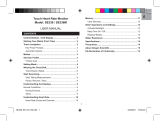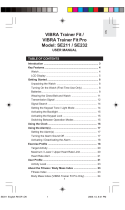
10
EN
IMPORTANT If the heart rate icon does not appear on the display
or is not flashing because no signal has been found, force a signal
search. See “Signal Search” section for how to do this.
In the event that you experience a weak signal or your signal is
disrupted by interference in the environment, follow the instructions
below to identify and resolve the situation.
1. The signal is weak – the watch will only show “0”:
• Shorten the distance between the heart rate chest belt and watch.
• Re-adjust the position of the heart rate chest belt.
• Check the batteries. If they are low or exhausted, the range may be less.
• Force a signal search (see “Signal Search” section).
2. Interference from another person’s heart rate monitor – their heart
rate readings appear on your watch, or the watch shows “0”:
• Take the chest belt off for 12 seconds to automatically change
your User ID. (The watch has 4 User ID’s. When the watch
receives the chest belt signal it will tell you which User ID it
has selected. Only products with a digital coding system have
User ID capability.)
NOTE The heart rate readings may interfere with other users if the
distance is less than 84 cm (33 inches).
3. The signal is jammed – the heart rate reading on your watch is flashing:
• There is too much interference in the environment for your
heart rate monitor to function. Move to an area where the
heart rate reading stops flashing.
WARNING Signal interference in the environment can be due to
electromagnetic disturbances. These may occur near high voltage
power lines, traffic lights, overhead lines of electric railways, electric
bus lines or trams, televisions, car motors, bike computers, some
motor driven exercise equipment, cellular phones or when you walk
through electric security gates. Under interference, the heart rate and
speed readings may become unstable and inaccurate.
SIGNAL SEARCH
To force a signal search:
1. Press MODE to enter SPEED, TRAIN or CHRONO Mode.
2. Press and hold MODE for 2 seconds. The signal-searching icon
with
the outside flashing will appear to confirm a signal search is taking place.
Whenever the watch is searching for the chest belt signal, make sure that
the chest belt is no further than 10 cm (4 inches) from the watch.
SE300_M_EN_USA.indd 10 8/31/06 12:13:01 PM




















 Oregon Scientific SE188 Användarguide
Oregon Scientific SE188 Användarguide
 Oregon Scientific Heart Rate Monitor SE188 Användarmanual
Oregon Scientific Heart Rate Monitor SE188 Användarmanual
 Oregon Scientific ZONE TRAINER SE331 Användarmanual
Oregon Scientific ZONE TRAINER SE331 Användarmanual
 Oregon Scientific SE833 Användarmanual
Oregon Scientific SE833 Användarmanual
 Oregon Scientific SE336 Användarmanual
Oregon Scientific SE336 Användarmanual
 Oregon Scientific SL210 Användarmanual
Oregon Scientific SL210 Användarmanual
 Oregon Scientific SE232 Användarmanual
Oregon Scientific SE232 Användarmanual